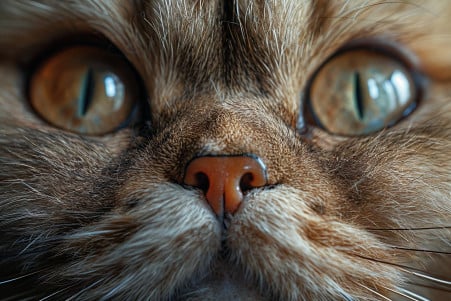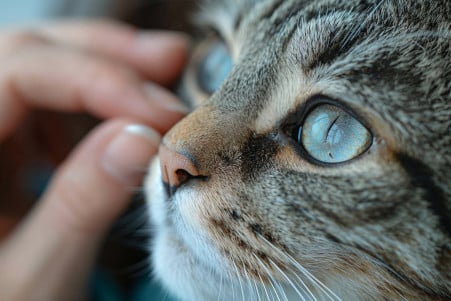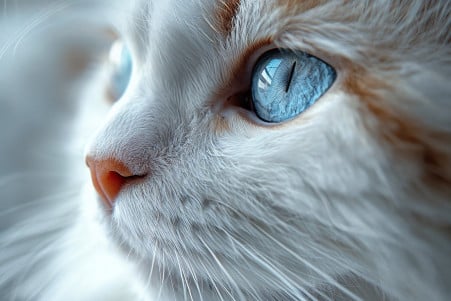Why Do Cats Cry Tears? The Science of Watery Cat Eyes
26 May 2024 • Updated 25 May 2024

Cats don’t cry tears in response to their feelings, but they do produce tears and other eye secretions for a number of biological and environmental reasons. In addition to environmental irritants, such as dust and smoke, cats can develop watery eyes due to respiratory infections and conditions like feline viral rhinotracheitis, as well as eye and tear duct injuries and abnormalities.
This article will delve into the biological and anatomical reasons for cats’ watery eyes and the overflow of their meibomian gland secretions onto their fur. By looking at the latest veterinary research, cat behavior studies, and evolutionary science, you’ll learn more about this mysterious and little-studied cat behavior. Knowing why your cat’s eyes are watering can help you understand more about their health and well-being.
Do cats cry tears?
The Cat Tear Duct System: Anatomy and How It Works
Cats have a unique nasolacrimal duct system that makes and drains tears from the eyes to the nose and mouth. The lacrimal gland is responsible for making the tear film, which consists of an outer lipid layer, a middle aqueous layer, and a deep mucus layer. The tear film is important for keeping the eyes moist and protecting the cornea.
If the nasolacrimal duct becomes blocked or inflamed, it can cause the eyes to water and become irritated. This is because the tears can't drain away properly. Some of the most common reasons for problems with the tear ducts include anatomical abnormalities, infections such as feline herpesvirus, and foreign bodies. In addition, chronic viral infections can cause scarring that blocks the tear ducts.
Knowing the ins and outs of the tear duct system and how the nasolacrimal system works can help you understand when there might be a problem that's causing your cat's watery eyes. In some cases, excessive tearing can be a sign of an underlying health condition that needs to be treated by a vet, and we'll cover these in the next section.
Medical Reasons for Watery Eyes in Cats
Respiratory infections like feline viral rhinotracheitis can cause watery eyes and nasal discharge in cats. Eye injuries, corneal ulcers, and conditions like glaucoma can also cause watery eyes. Allergies to environmental irritants like dust, smoke, or pollen can cause eye inflammation and watery eyes.
Blocked tear ducts due to infections, congenital defects, or foreign material are another common cause. Chronic dry eye (keratoconjunctivitis sicca) is a rare condition that leads to decreased tear production in cats. It is important to know the signs of these medical issues because watery eyes can be a symptom of an underlying problem that needs to be treated by a vet.
How Do Cats Show Emotion?
Although cats can’t cry tears of sadness, they can express a wide range of emotions through body language and vocalizations. Cats are social animals that can form strong social bonds and recognize the emotions of other cats and humans, and they can adjust their behavior based on these emotions.
Cats’ facial expressions, including slow blinking, ear position, and pupil dilation, can show how a cat is feeling. For example, a cat that is slow-blinking is often showing friendly and approachable behavior, while a cat that is staring with hard eyes, ears forward, and pupils constricted is showing offensive and confident behavior. In addition, a cat’s body posture, tail position, and vocalizations like purring and hissing can also show how a cat is feeling, whether it’s happy, fearful, or aggressive.
Studies have shown that cats can feel a variety of emotions including fear, anxiety, happiness, and even depression. Cats can also form emotional bonds with their human owners, sometimes even viewing them as their mothers. Recognizing these signs of feline emotions can help cat owners better understand and care for their pets and even strengthen the bond between pet and owner.
Emotional Tears: A Human-Specific Behavior?
Humans are the only species that cry emotional tears in response to feelings and mental states. The Smithsonian's National Zoo explains that while animals do make tears to keep their eyes moist and protect them from irritants, emotional crying seems to be exclusive to humans.
Various theories have proposed that this trait evolved to elicit care and support from others and to promote social bonds. Scientific American notes that there have been a few anecdotal observations of possible emotional crying in animals like elephants, gorillas, and wolves, but the empirical evidence is scarce.
More recently, a study highlighted by Discover Magazine has suggested that there may be emotional crying analogs in dogs, pigs, and rats in response to positive or negative situations. Still, most researchers agree that the ability to cry emotional tears is unique to humans.
When to See a Vet for Cat Eye Discharge
If your cat's tearing is excessive and lasts for more than a few hours, it may be a sign of an underlying issue that needs to be addressed by a vet, according to Catster. Other symptoms like redness, squinting, discharge, or a change in the appearance of the eye in addition to tearing are also reasons to take your cat to the vet, according to The Wildest.
Tear duct blockages or infections are often diagnosed with the help of dye tests that determine if the tear ducts are draining properly. Depending on the diagnosis, treatment may involve medications such as antibiotics or anti-inflammatories, or in more severe cases, surgery, according to the Merck Veterinary Manual.
It's important to address the underlying cause as soon as possible since eye problems that go untreated can lead to vision issues and discomfort for your cat. Knowing when to see a vet for cat eye discharge will help you make sure your cat's eyes stay healthy and comfortable.
Conclusion: What You Need to Know About Cat Tear Ducts
Although cats don’t cry tears in the way humans do, their eyes can water for a number of medical reasons that are related to the nasolacrimal system. Excessive tearing can be a sign of health problems such as infections, injuries, allergies, or tear duct abnormalities. It’s important to be able to recognize when a cat’s tearing is abnormal so that you can get them the care they need to keep their eyes healthy and comfortable.
Instead of crying tears, cats communicate their feelings through body language, vocalizations, and social behaviors. Meanwhile, the ability to cry emotional tears seems to be unique to humans, although this is an area of ongoing research.


